San Tan Valley Addiction Treatment & Mental Health Resources Guide

Dr. Rostislav Ignatov, MD
Chief Medical Officer
San Tan Valley is not immune to Arizona’s addiction crisis. Across Pinal County, families continue to feel the effects of rising fentanyl use, gaps in mental health support, and uneven access to care. Yet alongside these challenges, the region is building real solutions through public health programs, treatment providers, and a growing recovery community.
Statewide, Arizona recorded 1,927 opioid overdose deaths in 2022—more than five lives lost every day—and fentanyl has become the most common driver of fatal overdoses since 2015. But there is progress too: nearly 45,000 Arizonans engage in treatment each year, supported by AHCCCS (Arizona Medicaid), crisis response services, and an expanding network of evidence-based providers.
For San Tan Valley residents, treatment is within reach. The Haven Detox – Arizona provides comprehensive addiction and mental health care serving residents of San Tan Valley and surrounding communities. Options range from medical detox and residential programs to outpatient therapy, medication-assisted treatment, peer recovery centers, and culturally responsive services.
While cost remains a barrier for about 40 percent of people who seek care, expanded coverage and navigation support are opening more doors than ever before. This guide outlines how to find drug rehab programs, mental health treatment, and recovery resources in San Tan Valley and greater Pinal County—so you can understand your options and take the next step toward healing.
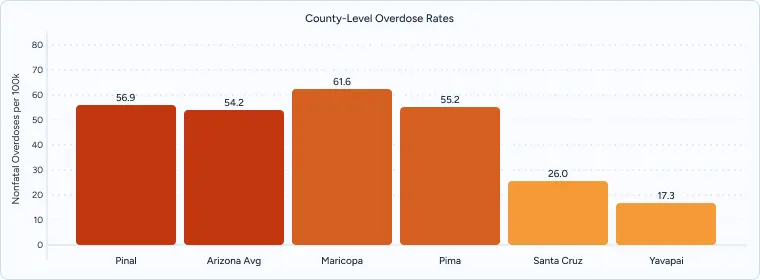
In 2023, Pinal County reported 56.9 non-fatal opioid overdoses per 100,000 residents—slightly above the statewide rate of 54.2. Neighboring urban counties recorded even higher levels, with Maricopa at 61.6 and Pima at 55.2. By contrast, smaller rural counties such as Santa Cruz (26.0) and Yavapai (17.3) saw far fewer non-fatal overdoses. Within the greater Phoenix–Tucson corridor, Primary Care Area data illustrate the starkest disparities: Central City Village reached 195 per 100,000, Mesa West 171, Tucson South 150, Tempe North 135, Buckeye 130, Glendale North 101, and Tucson Central 108. For San Tan Valley, this means living in a county already above average, surrounded by urban pockets with some of the highest overdose burdens in the state.
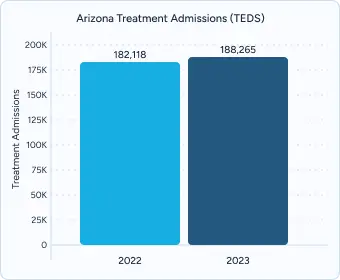
Even as overdoses remain elevated, Arizona continues to see strong demand for treatment. According to SAMHSA’s Treatment Episode Data Set (TEDS), Arizona recorded 182,118 treatment admissions in 2022 and 188,265 in 2023—a 3.4 percent increase year-over-year. With an admissions rate of 2,931 per 100,000 residents, the state ranked among the highest nationally. These numbers reflect significant engagement in care, but they also underscore how many Arizonans need treatment—and how financial barriers, workforce shortages, and uneven provider distribution continue to limit access, particularly in fast-growing communities like San Tan Valley.
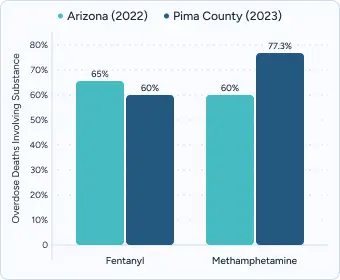
State and county surveillance show fentanyl and methamphetamine as the most common substances involved in overdose fatalities. In Arizona, fentanyl was detected in more than 65 percent of overdose deaths in 2022, while methamphetamine appeared in roughly 60 percent. Pima County’s 2023 toxicology reports showed even higher involvement (77.3 percent meth, 60 percent fentanyl), a trend that mirrors Pinal County’s proximity to the border and position along major trafficking routes. For San Tan Valley residents, this means exposure to a drug supply that is increasingly polysubstance in nature—heightening both overdose risk and the complexity of treatment.
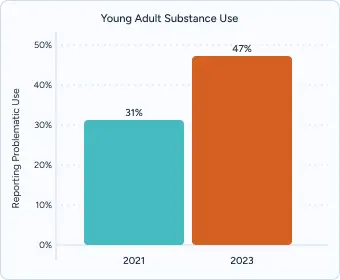
Nearly 47% of residents ages 25–34 report problematic substance use—up from 31% in 2021. Risk is higher among Hispanic/Latino young adults, veterans, and those experiencing homelessness. Even more concerning, fewer than 50% receive timely support during substance-related crises, limiting opportunities for early intervention and recovery.
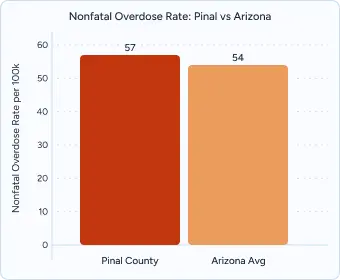
San Tan Valley is part of Pinal County, which reports a higher non-fatal opioid overdose rate (~57 per 100,000 in 2023) than Arizona overall (~54 per 100,000). State mortality data underscore who is most affected (deaths per 100,000): Black residents 41.9, American Indian/Alaska Native 24.5, Hispanic/Latino 24.0, White 23.8 (state rate 25.6).

Intensive Treatment Systems San Tan Clinic serves as a centralized access point for treatment information and referrals. The program includes medical detox and outpatient services, distributing over 1,000 naloxone doses in 2024.
EMPACT Suicide Prevention Center provides 24/7 crisis intervention, covering San Tan Valley and Queen Creek areas. With locations at 2474 East Hunt Highway Suite A100 and satellite offices, it offers crisis stabilization, mental health counseling, and a comprehensive outpatient program.
Transportation accessibility through Valley Metro links all neighborhoods to San Tan Valley drug rehab programs and mental health facilities. The Route 108 provides access to Mesa facilities, while Routes 112 and 136 connect downtown to areas like Gilbert and Chandler. The Dial-A-Ride service offers specialized transportation for individuals with disabilities seeking treatment.
AHCCCS covers medically necessary care for eligible Arizona residents—including medical detox, residential treatment, partial hospitalization (PHP), outpatient programs (OP), peer support, and FDA-approved medications such as methadone, buprenorphine, and naltrexone. Coverage extends to adults up to 138% of the federal poverty level (FPL). Many behavioral health copayments are waived, and crisis services are available 24/7 at no cost.
Arizona Complete Health (and other AHCCCS plans) coordinate benefits, care management, and crisis responses for children and adults. Enrollment is simple: apply through the Health-e-Arizona PLUS portal or call 1-855-432-7587 for help in English or Spanish.
If you don’t qualify for AHCCCS, Arizona’s state-funded Substance Use Disorder services can help residents with limited income access treatment, generally up to ~200% of the federal poverty level (FPL). Pinal County also offers navigation and wraparound assistance for uninsured residents—visit the county health services site or call 520-866-6565 to locate open treatment slots and community resources.
For residents who want help without long waitlists, several San Tan Valley–area programs (including nearby East Valley and Tucson facilities) offer fast admissions with free insurance verification. These centers provide comprehensive assessment, medical detox when needed, and evidence-based care—such as cognitive behavioral therapy (CBT), dialectical behavior therapy (DBT), trauma therapy, and medication-assisted treatment (MAT)—in supportive, private settings.
Private facilities often provide advantages over state-funded programs including:
Insurance and benefits verification is available within 24–48 hours and can coordinate same-day admission when clinically appropriate.
The Haven Detox – Arizona (Green Valley) offers immediate access to medical detox and residential treatment using evidence-based approaches, including EMDR, DBT, trauma-focused therapies, and CBT, paired with holistic supports like art therapy, yoga, music therapy, and nutrition counseling. A high staff-to-client ratio supports individualized attention, and amenities include professional chef-prepared meals, mountain views, private rooms, fitness facilities, and 24/7 nursing. The program treats adults with co-occurring disorders, accepts most major insurance plans—including AHCCCS/Medicaid—and provides transportation assistance across Arizona and neighboring regions. Learn more about programs and admissions at The Haven Detox or call the 24/7 helpline for personalized guidance.
San Tan Valley mental health services span the East Valley with specialized programming for depression, anxiety, trauma, and dual-diagnosis care. Community behavioral health centers in Queen Creek, Mesa, and Gilbert offer culturally responsive treatment with bilingual providers (including services through Pinal Hispanic Council), medication management, telehealth access, and trauma-informed approaches such as EMDR, trauma-focused CBT, and family therapy.
Neighborhood-specific mental health resources help residents find support close to home. Programs such as Total Life Counseling provide community clinic counseling, intensive outpatient services, and DBT skills groups for youth and families. Providers including Camelback Recovery and Grand Canyon Psychiatry offer peer-led groups, care coordination, and specialized psychiatric services with attention to Hispanic/Latino and Native/Tribal communities. Across the East Valley, mental health counseling integrates with substance use treatment to deliver comprehensive co-occurring care.
San Tan Valley Peer Recovery Center in Queen Creek (19729 E San Tan Blvd)
Offers free peer-led recovery support, specialized support groups for various addictions, and sober social events with weekend programming.
East Valley Recovery Support in Mesa (6935 E Williams Field Rd)
Features culturally responsive groups for Hispanic communities, transit-accessible location on Valley Metro routes, and evening hours with social media engagement @EastValleyRecovery.
Apache Junction Community Recovery in Apache Junction (1050 W Superstition Blvd)
Provides peer coaching, family support groups, and specialized programming for veterans and older adults with flexible scheduling.
AzRHA-certified sober homes provide structured transitional housing that follows National Alliance for Recovery Residences (NARR) quality standards. The Arizona Recovery Housing Association directory at myazrha.org lists independently reviewed, certified residences across the East Valley—including San Tan Valley, Queen Creek, Gilbert, Mesa, and Apache Junction.
Tilda Manor – Gilbert offers NARR-aligned, AzRHA-certified recovery housing with 24/7 staffing, secure entry, community kitchen, Wi-Fi, laundry, and on-site parking. Resident expectations typically include weekly house meetings, chore rotations, and regular sobriety screenings to support accountability and stability.
Transitional Living Communities – Apache Junction maintains state alliance certification and a structured program featuring peer mentoring, life-skills training, employment assistance, and transportation support. House guidelines commonly include meeting attendance, a 10 p.m. curfew, and mandatory drug screenings to help residents build safe routines during early recovery.
Phoenix Area Intergroup coordinates 400+ AA meetings each week across Greater Phoenix and the East Valley, with an online directory and Meeting Guide app listings for in-person and virtual options. Daily updates help residents in San Tan Valley, Queen Creek, Mesa, and Gilbert find nearby meeting sites fast.
Spanish-language meetings support Latino communities throughout the East Valley. The Phoenix AA Hotline (602-264-1341) offers bilingual assistance and directs callers to Spanish-speaking groups; many locations also share information about Al-Anon/Alateen for families.
Veteran-focused recovery groups provide peer support for service members, veterans, and their families. The VA Phoenix Health Care System and community partners host AA/NA and SMART Recovery meetings; clinical services are coordinated through VA benefits or TRICARE/TriWest, while community meetings themselves are free and open.
Comprehensive assessment should evaluate both substance use and mental health conditions. Look for programs that screen for trauma, involve family when appropriate, and deliver truly integrated dual-diagnosis care guided by a personalized plan.
Medication-assisted treatment (MAT) is a quality marker. Effective programs can provide (or coordinate) buprenorphine, naltrexone, or methadone when clinically appropriate—always paired with counseling and recovery support.
Culturally responsive care matters. Seek providers who offer Spanish-speaking clinicians, LGBTQ+-affirming services, and options that respect Native/Tribal healing traditions—ensuring care fits the needs of San Tan Valley and East Valley communities.
Continuing care planning ensures long-term success
Aftercare coordination should begin during treatment, linking clients to outpatient therapy (PHP/IOP/OP), peer support (AA/NA/SMART), and sober living options through warm handoffs with East Valley providers. Quality programs schedule the first follow-up within 7 days, ensure medication continuity (including MAT when appropriate), provide naloxone, and help with transportation and AHCCCS/insurance navigation to keep care seamless.
Family involvement and support services strengthen recovery. Programs should offer family therapy, education and skills groups (e.g., CRAFT), and connections to Al-Anon/Alateen and NAMI. Services need to be culturally and linguistically responsive—including Spanish-language options and Native/Tribal and LGBTQ+ families—with in-person and telehealth offerings so San Tan Valley households can stay engaged long after discharge.
Medication-Assisted Treatment (MAT) utilizes evidence-based approaches including methadone, buprenorphine, and naltrexone programs with ongoing staff certification and specialized training for opioid use disorders.
Alumni Networks support long-term recovery through quarterly reunions, peer mentoring programs, and digital support forums connecting graduates across Arizona treatment facilities.
Administrative Support Services include AHCCCS benefits navigation, sliding-scale payment consultations, and specialized roles including financial advocates and treatment referral coordinators.
Professional treatment represents an investment in recovery success, offering immediate access, personalized care, and comprehensive services designed to address the complex nature of addiction and mental health conditions.
Benefit checks are fast and clear. Teams review AHCCCS/Medicaid and commercial coverage (often within 24–48 hours), provide preliminary eligibility information, estimate any out-of-pocket costs, and discuss payment options when needed—so you can make informed decisions quickly.
Clinical assessments can occur same day when indicated, with next-day residential placement available in many cases. Programs streamline paperwork, arrange transportation when possible, and ensure smooth handoffs so you can begin treatment without delay.
Most programs schedule an initial assessment within 48 hours, then connect you with a therapist based on your needs and insurance coverage.
AHCCCS and Arizona state plans typically cover individual and group therapy with eliminated copayments for most services and extended eligibility criteria.
Yes. Many community centers offer bilingual and multilingual peer-support meetings, with Spanish-speaking facilitators and interpretation services available.
Several nonprofit clinics provide sliding-scale fees and state-funded treatment through Pinal Hispanic Council and other community providers.
Some programs partner with Valley Metro and paratransit services to offer free or low-cost transportation vouchers for clients.
Crisis hotlines and mobile response teams operate 24/7—call the statewide hotline 1-844-534-4673 for immediate behavioral health support.
Yes. Family peer specialists offer confidential coaching and referrals to Al-Anon, family therapy, or intervention services through EMPACT.
Look for centers offering Spanish-speaking groups, Native American healing circles, and veteran-focused support tailored to East Valley communities.
Yes. Many organizations run specialized programs, peer-led support circles, and workshops designed specifically for college-aged individuals and young adults.
Let’s talk about what’s going on — no judgment. (We’ve been there before ourselves). No one will know you inquired and there is no commitment to call.
24/7 Support
No Commitment
100% Private
There’s no catch. Checking your insurance is simply a way to see what your plan covers — it doesn’t lock you into treatment, notify anyone, or cost you anything. You get answers upfront to decide what makes sense for you.
Protecting your privacy matters! No information or notifications are ever sent to your employer or family — whether you check your insurance online or call. Everything is handled through secure, encrypted systems that meet strict medical privacy laws. You stay in control of your information!
Luckily, most insurance policies cover treatment here. Depending on the healthcare you’ve already had this year, costs could even be zero. Instead of worrying, let’s just find out what your plan covers.
Most likely. We work with major providers like Cigna, Aetna, and United Healthcare, public insurances like Tricare and tribal plans, and even smaller plans like Surest Bind and Harvard Pilgrim. The quickest way to know for sure is to check online or call. It’s a quick, private way to understand what is covered upfront.
Verifying your insurance isn’t a commitment to start treatment — it’s simply a way to see what your options are. Knowing your coverage ahead of time helps you make more informed, confident decisions. It also helps flag a spot, so you’re able to get right in if you ever do decide you’re ready.
You need your policy number to check your specific policy online. If you want general information, just call. You likely have questions beyond insurance anyway. Reaching out now helps you figure out the right fit if or when you’re ready. You don’t have to put off the call until you’re in crisis. Calling is not scary, I promise!